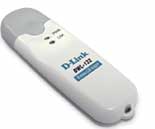 We
We
still have an original iMac (Bondi Blue). It runs at 233 MHz,
has 192Mb RAM and a hard-disk of 4Gb, so is pretty outdated. Still, when
Mac OSX was introduced I had a hard time installing extra RAM in it (for
this model you have to take it apart disconnecting all sorts of cables)
so it would be a shame if this oldest member of the family is left out
of the network. The problem is that it has an Ethernet card but no
possibility to include an Airport-Card… So I bought a D-Link Wireless USB adapter and was told that installation would be
plug-and-play : just connect it to the USB-port, open up the
Applications/Utilities/Airport Setup Assistant and everything
would rum smoothly. Hahah! When I started the Assistant it was clever
enough to detect that no Airport-Card was installed and refused further
action. But, there is a CD in the package so I did install the driver
which really adds a new icon Wireless Adaptor to the System
Preferences. Clicking it gave the sobering message No Wireless
Device Attached and I couldnt press the Scan button for detection of
possible networks. But disconnecting the D-Link a number of times and
pressing it very hard eventually I got a wireless icon in the toolbar
but still it couldnt give me a signal strength of available networks.
But that might be right as the ABS is protected both by WEP and by
MAC-access. So, I added the MAC-address of the D-Link to the list in the
Access Control pane of the Airport Admin Utility which
also gives a way to get at the Hex-equivalent of the WEP-key : click on
the Password icon. So, i manually created in the Wireless
Adaptor-preferences a network with the correct name, WEP-key equivalent
and so on and thought that would do it. But no, now I did get a signal
strength but it showed that I was not connected and that the WEP-key was
incorrect. On the other hand, no complaints were listed when i tried to
access the ABS as Peer-to-peer but this created all other sorts
of problems as I could detect with iStumbler so I quickly removed
this option and got to bed.
This morning I realized
that I still have the old Graphite Airport Base Station lying
idle so I connected it with a patch cable to the Router, reconfigured it
without WEP-protection and without Access Control and instructed
BondiBlue to connect to this new network, which it immediately managed
to do but it took a few restarts and time to get it onto Internet and
connected to other computers on this second network. So, now I will
increase security on this new network and see where it fails. First, add
Access Control by including the MAC Address of the D-Link and other
computers, reconfigure the ABS and the BondiBlue is still on the
network! Next, WEP : in the Apple documentation it is mentioned to take
a passphrase of exactly 5 symbols to ‘increase compatibility with
third-party products’. Let’s try ab;12, change in the
Wireless Adaptor-Prefrences the properties of the network by
choosing Enable WEP 40 Bits ASCII (5 characters) and give the key
ab;12 and sure enough : everything works! So the problem was that
our regular network is WEP-protected by a longer passphrase and D-Link
could not handle the HEX-equivalent 10 digit number. A final attempt :
in the D-Link documentation a solution is offered by giving the ABS a
10-digit Hex together with a starting $-sign so let’s try
$4bb2603b52 on the ABS and 4bb2603b52 in the properties of
the D-Link preferences : success!
However, if I try
any of these two methods on the Airport Extreme base-station,
none of this works! If it were not for the USB-network printer on the
extreme ABS I would just replace it again with the Graphite. Still, I’m
fed up with it for today, BondiBlue is online but via Graphite and all
other computers can communicate with it when they change stations.
Comments